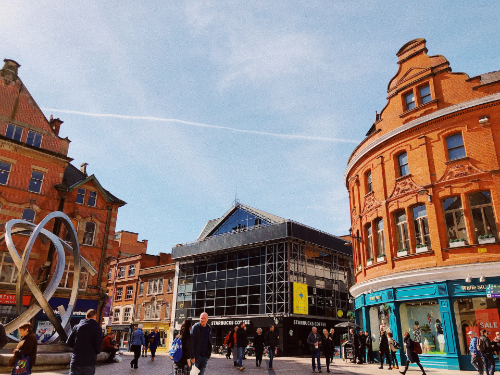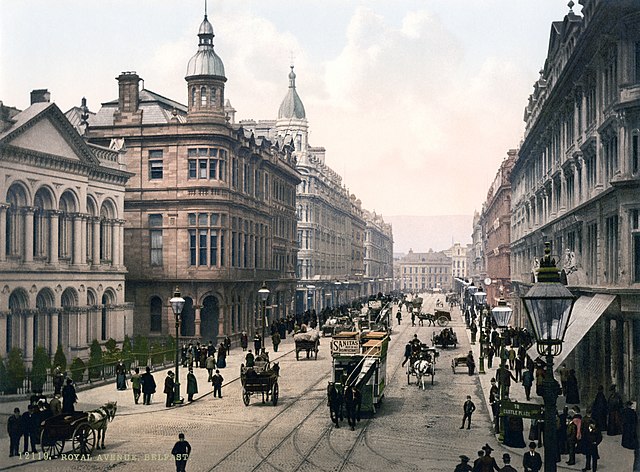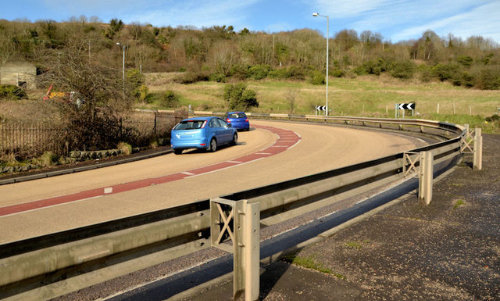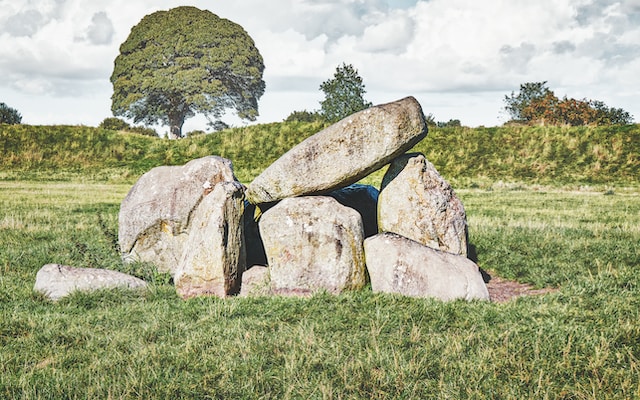Belfast is the capital of Northern Ireland, and its site has been occupied since the Bronze Age. It’s been a major port since the 19th century, and the Harland & Wolff shipyard built RMS Titanic here.
It’s a city of much history, both violent and industrial, so it comes as no surprise that there are plenty of ghost stories linked with Belfast. Haunted prisons, railway stations, private homes, even roads – Belfast has the lot.

So let’s explore some of these Belfast ghost stories – and a particularly weird experience at one of its Bronze Age sites – in this instalment of Fabulous Folklore! This post is part of my Folklore of UK Capitals series.
York Road Railway Station
The station opened in 1848 to serve the north of Belfast. It suffered heavy bomb damage during a 1941 air raid and had a somewhat chequered history until its closure in 1992. It’s since been demolished so there’s nothing to see, but it’s worth including due to the stories that clung to it while it was open.
Most famously, staff sometimes saw a figure sitting in the canteen after hours. That was weird enough, but it was even more weird since the canteen was locked for the night.

Another figure appeared in the running sheds. A robbery went wrong at the station in the mid-1970s, in which a worker was either shot or beaten. He died later from his injuries, so commentators wonder if he remained to hang around the station. No one knows the figure in the sheds was the same one from the canteen.
Those working in the station at night also reported disembodied footsteps in the area. One night, someone – or something – threw a fire extinguisher at night staff (Paranormal Database 2023). Again, no one knows who or what was responsible.
Other travellers reported seeing figures in empty train carriages and even on the railway itself. Most sightings happened in the early morning or late at night (Love Belfast 2022). Seeing ghosts in the early morning isn’t surprising since it’s one of those infamous liminal times of day, midway between night and day. Both times are also times when it’s a lot quieter in terms of foot traffic, making it easier to spot someone since there are fewer crowds to get in the way.
Crumlin Road Gaol
If railway stations have a surprising number of ghosts, then we expect to find a few resident spectres lurking in prisons. Many consider Crumlin Road Gaol haunted, most likely linked to the seventeen executions that once took place here. Fifteen of those prisoners still rest within the walls, while the other two now lie in Milltown Cemetery.
Built in 1846, the prison is the only one from the Victorian era still to be found in Northern Ireland. Its last prisoner left in 1996 and it officially closed in 1998.

Now a museum, the building yields experiences such as doors slamming shut on their own, women calling for help, or the sighting of a man who walks down C wing before disappearing. Surprisingly, many sightings seem to involve wardens, rather than prisoners.
The museum also offers ghost hunt experiences, and Belfast Live features a couple of apparent ghost photos taken on tours, though the images are incredibly grainy and open to interpretation.
That said, one of them depicts what looks like a man in uniform in B wing, which was closed at the time of the woman’s visit. While the photograph isn’t conclusive enough to say it is a phantom warden, there are reports of one in this part of the building. People report the sound of footsteps in the wing, often attributed to the warden. He also might be the dark figure seen drifting between the cells (Young 2013).
A tunnel runs beneath the road between the prison and the courthouse opposite. While the prison was open, wardens reported seeing a grey figure in the tunnel. Perhaps this is the figure responsible for the groans, sighs, whistles, and coughs captured on recorders by ghost hunters in this tunnel (Young 2013).

Other activity seems linked to the padded cell in B wing, and the room in which executions took place.
The Royal Avenue Poltergeist
We can imagine that those who lost their lives in the prison might remain in the place that caused them so much pain. But not all ghosts end up sticking around – sometimes, we can help them to leave.
This is what happened at the top end of what is now Royal Avenue, originally called John Street. One of its houses apparently suffered from a poltergeist. At least, the stories call it a poltergeist, but they also refer to the ghost of an angry old woman. She seems to have acted like a poltergeist, at least.

Reports explained how the ghost caused havoc, throwing cups and plates, and even furniture. According to one report, she destroyed everything that was in the back garden. One of those who lived in the house claimed to see a ghostly woman pacing in the back room while muttering. Whoever the woman was, she was not happy.
Yet it seems this ghost story actually has a happy ending, if such endings can be called ‘happy’. In the early 1880s, workers needed to put new pipes under the house. They opened up the foundations and came across a woman’s skeleton. She’d clearly been there for some time (Morris 2022).
The authorities exhumed the bones and gave them a proper burial at the Union Graveyard. No one saw the angry old woman again. It’s a shame that no one knows who she was, or why she was buried under the house, but burial seems to have quieted the spirit.
Smithfield Market
The area around Smithfield Market is said to boast several ghosts. Perhaps the most famous is that of Biddy Farrelly. She was the lover of local businessman, Luke White, who ran a bookstall in the Smithfield Market area. He abandoned her when he left for Dublin to seek his fortune.
Some versions of the story say that White left her a sum of money before he moved. Others say he left her a sum of money when he died. Either way, she ended up with £250. Having already turned to drink when he abandoned her, she drank herself to death. Some say she hoped to join him in death.

According to legend, she still wanders the area, especially around Gresham Street, looking for her lover. Some sources say she carries a bundle of ballads, which would make sense due to White’s job as a bookseller.
The book shop Harry Halls became a cafe named Biddy Farrelly’s Cafe, at 39 Gresham Street. This is listed on Google as being permanently closed, though it was nice to see Biddy’s story immortalised by the business..
The Phantom Hitchhiker
Horseshoe Bend features a sharp bend on the Crumlin Road, as well as a steep gradient. So there have been plenty of accidents over the years. Such a location is an ideal location for tales of a phantom hitchhiker.
Albert Bridge notes it was once the main road between Belfast and the international airport (2014).

It’s been the site of a phantom hitchhiker since the early 1970s. Motorists saw the hitchhiker waiting on the bend, and slowed down as they approached. As they got closer, he disappeared without a trace.
It seems a group of friends last saw him in 2008. Yet what’s fascinating about the site is how open it is. There aren’t any trees, so drivers can’t have mistaken something else for a figure. I’m also not sure how much of a hitchhiker he is, since phantom hitchhikers usually let themselves be picked up, and then disappear. So no one knows who the figure is, why he’s there, and if he relates to any of the past accidents.
If you’ve ever seen him, let me know!
The Giant’s Ring
We couldn’t stick solely to ghost stories in this post – not for a city that stands on land occupied since the Bronze Age. The best indication of this is the Giant’s Ring, a Neolithic henge monument at Ballynahatty. It’s over 200 m in diameter, and a dolmen sits in the centre.

As you can imagine, legends of sacrifice and dark rituals cling to the site, as they often do around such ancient monuments – but mostly conjured up by 19th-century writers. Others think it was a burial site, which would make sense given the ruined passage tomb. And yet more people think that ancient pagans celebrated their dead there.
In typically Victorian style, J.B. Doyle described the dolmen as “a Druid altar”, while the whole site was “a vast heathen temple, within the circuit of which many thousands may have assembled to witness the awful rites of their sanguinary religion” (1854: 98-9). According to him, the whole point of these rituals was apparently sun worship. There’s no evidence for any of these claims.
As Howard Goldbaum points out, no one knows where the name “Giant’s Ring” comes from, because no stories of giants are linked to the site (no date).
But there is folklore attached to the area. In some stories, a mist suddenly appears within the henge, taking those within it by surprise. No matter which direction those caught within the mist try to turn, they always end up back at the dolmen. That sounds terrifying, though people do eventually manage to get away!
What do we make of these Belfast ghost stories?
One of the fascinating things about ghost stories is how they bring us into close contact with a place’s history. In this way, I feel ghost stories are part of folklore, because they keep stories that ordinary people believed in the public domain.
These Belfast ghost stories are particularly interesting because they cover a range of people. We have ordinary workers, different types of locations, and even named individuals. Even when the place no longer exists, like York Road Railway Station, the stories remain.
And there are so many more ghost stories related to the city. So if these tales piqued your interest, I highly recommend tracking down some of the others!
Which is your favourite story?
References
Bridge, Albert (2014), ‘The Horseshoe Bend, Crumlin Road, Belfast’, Geograph.ie, https://www.geograph.ie/snippet/10598.
Doyle, J. B. (1854), Tours in Ulster: A Handbook to the Antiquaries and Scenery of the North of Ireland, Dublin: Hodges and Smith.
Goldbaum, Howard (no date), ‘BALLYNAHATTY GIANT’S RING’, Voices from the Dawn, https://voicesfromthedawn.com/giants-ring/.
Love Belfast (2022), ‘8 Creepy Places in Belfast’, Love Belfast, https://lovebelfast.co.uk/8-creepy-places-in-belfast/.
Morris, Katie (2022), ‘Top 5 spooky ghost stories from Belfast’, Ireland Before You Die, https://www.irelandbeforeyoudie.com/top-5-spooky-ghost-stories-from-belfast/.
Paranormal Database (2023), ‘County Antrim Ghosts, Folklore and Forteana’, The Paranormal Database, https://www.paranormaldatabase.com/ireland/antrim.php.
Young, Mark (2013), ‘Crumlin Road Gaol: What Ghosts Lurk Within Its Walls?’, Spooky Isles, https://www.spookyisles.com/crumlin-road-gaol/.
Nutty about folklore and want more?
Add your email below and get these posts in your inbox every week.
You'll also get my 5-step guide to protecting your home using folklore!








Have your say!